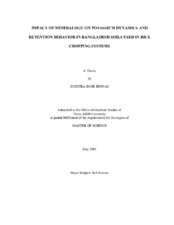| dc.description.abstract | The combination of rising population and increasing food demand has placed
tremendous pressure on the soil resource in Bangladesh, especially floodplain soils
where rice may be grown year round. Although these floodplain soils contain minerals
high in potassium (K) such as micas, K deficiency in rice paddy soils is increasing
throughout Bangladesh. Harvesting of straw from fields exacerbates the removal of
nutrients including K, and intensive cropping with unbalanced fertilizer has resulted in
depletion of "readily available" K in large areas.
Five representative floodplain soils in rice production were sampled by horizon
to determine physical, chemical and mineralogical properties, assess soil K, investigate
plant available K, and understand impacts of redox on K fixation and release.
Total and nonexchangeable K were determined using concentrated hydrogen
fluoride (HF) digestion and 1.0 M HNO3 digestion, respectively, along with NH4OAcextractable
K. Cation exchange capacity under both oxidized and reduced conditions
was determined. Assessment of adsorption and release of K as a function of redox was done in conjunction with seven different concentrations of potassium chloride (KCl)
solution and three different soils.
Significant amounts of K were present in all fractions of silts and clays.
Potassium concentration was greatest in the coarse clay fraction. High HNO3-
extractable K suggested that much of the K in soils was from mica interlayers. Acidic
soils contained less K in all fractions than the less weathered, calcareous soils. The clay
fractions exhibited mostly mica, vermiculite, smectite and kaolinite. The cation
exchange capacity (CEC) of reduced soils was less under oxidized condition, due to
collapse of the interlayer in response to increased layer charge upon structural Fe
reduction.
The adsorption of K was greater for calcareous soils under both oxidized and
reduced conditions than for the acidic soils. Less native K was extracted under oxidized
conditions than under reduced conditions. Less adsorption under reduced conditions may
be due to an increase in solution Fe2+ which can compete with K+ for exchange sites on
clays. | en |


